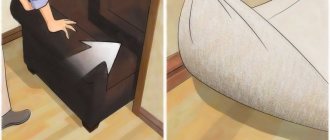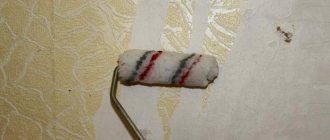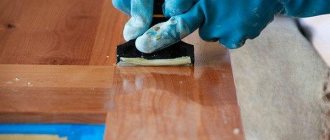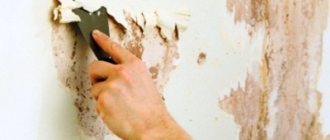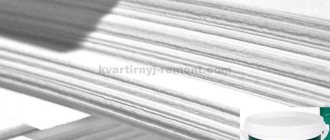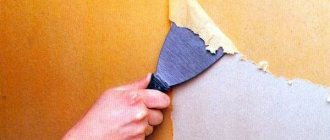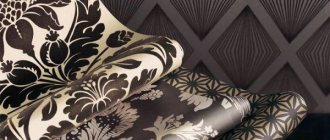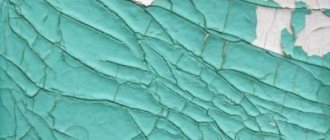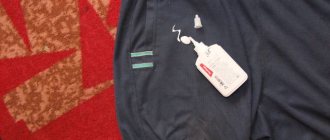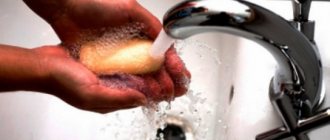Universal methods for removing wallpaper
Dry removal method
Equipment: spatula, scraper, knife.
Procedure: pull the corner and the sheet of paper will come off on its own. Do not make sudden jerks, as the old paper will crumble. If you feel that in some places the paper is attached to the wall tightly enough and cannot be removed, use either a spatula or another method of removal (for example, wet).
The method is ideal for cases when the canvases hardly stick to the wall.
Wet removal method
Equipment: rag, container with water, knife (or other sharp object), spatula.
Procedure: moisten a cloth generously with water and wipe the trellis
It is necessary to pay attention to the optimal intensity of wetting. If you pour a lot of water, it will flow down the wall, and the whole procedure will lose its meaning.
If it’s not enough, the wallpaper won’t get wet. To wet, you need to take a small surface (1 strip is enough, otherwise the paper will have time to dry) and wait for half an hour. It will be good if you make cuts on the wallpaper strips - blotting will be of high quality. Any available means will do. After which the paper is removed with a spatula. In this case, the problem of how to remove old wallpaper will not arise.
Traditionally used for all types. Water allows you to do the job cleanly. There will be less dust than with the dry method.
Special removal products
Equipment: rag (roller, brush), container with water, coating remover (for example, Neomid, Metylan), gloves (in case of using toxic household chemicals).
Procedure: Apply the solution to the wall. After the time has passed, remove the fallen wallpaper.
The products are sold in different forms: powder, gel, liquid. In any case, they are diluted in water in the proportions indicated on the package. These products are economical. One bottle is enough for 70 - 100 sq. meters. The disadvantage of this method is the duration of the procedure. After treatment you will have to wait from 1 to 3 hours. But the wallpaper will come away from the walls on its own.
Of all the industrial products, “Mole” stands out - a liquid for cleaning pipes. If you apply liquid to the canvas using a roller, after a few minutes it will fall off. The downside of "Mole" is toxicity. You need to wear gloves when handling the wall. Then carefully remove any remaining liquid so as not to get a chemical burn.
This option is universal. This is especially convenient for removing thick wallpaper, on which ordinary water has little effect.
Steam method
Equipment: iron (steam generator, steamer), container with water (if using an iron), piece of cloth, spatula, knife.
Procedure: moisten the fabric in water, apply it to the wallpaper and iron it with the hottest possible iron. After this procedure, the old trellises and glue will become soft and can be easily removed with a knife or spatula. If the house has a more modern device - a steam generator, then it will take several minutes before the wallpaper peels off the wall. After all, steam is more effective than water. The main condition is to keep the steam generator at a distance of 5 - 10 cm from the wall. In this case, a rag will no longer be needed. The method is easy to use.
The options listed are suitable for all types of coatings. But they will be more effective when working with paper. Other types of wall coverings have their own specifics.
Preparation
In order to effectively cope with this task, you need to prepare the room. The floor must be covered with polyethylene and secured with tape. All paintings and other objects should be removed from the walls. Move the furniture to another room.
Removal with a steamer
Sometimes wallpaper can be removed quite easily - just pull the canvas and it will immediately peel off from the wall. Sometimes you have to wet the wall with water, keep them in this state for 15-20 minutes and then remove the canvas with a spatula. If there is strong glue under the trellises, you will have to use a special tool - a steamer, which will help solve the problem quickly and easily.
Advice. To save money, we recommend using not a steamer, but a household steam cleaner or a simple iron with a steam generator.
A steamer costs a lot in a store; buying it for one-time use is a big waste. Purchasing this tool makes rational sense only in one case - if you are going to make professional money from repairs. The steamer method is ideal for ordinary paper sheets, but in the case of washable wallpaper it is not the best.
Tools and materials
The choice of tool depends on the type of old finish that needs to be removed. Here is the most complete set of tools and devices that will help you quickly peel off obsolete wallpaper that has lost its former attractiveness:
- knives, spatulas, scrapers;
- “wallpaper tiger” or roller with nails;
- steam generator;
- wide roller with extension handle (for ceiling);
- hard brush;
- spray;
- special liquid for removing wallpaper;
- drill or grinder with a brush attachment;
- old blankets, film or packaging cardboard to protect furniture and floors;
- gloves and headgear;
- scotch;
- old rags or sponge;
- container with warm water.
You are unlikely to need a full arsenal, but it won’t hurt to stock up on most auxiliary equipment.
Before removing old wallpaper, do not forget to remove everything unnecessary from the room, remove curtains, take out carpets, and seal sockets and switches with tape to prevent moisture from entering them.
Removing double-layer wallpaper
If it is necessary to dismantle wallpaper consisting of two layers, they must be removed layer by layer. First, the top layer is removed, and then the bottom layer.
- the top layer is removed using the technology described for moisture-resistant surfaces, with preliminary disturbance of the surface to allow water penetration;
- the bottom paper-based layer is also removed after pre-wetting the surface;
- When dismantling the fabric base, in addition to the measures listed above, it may be necessary to use a grinding wheel or other mechanical action.
To remove vinyl wallpaper, you can use specialized solutions. Before using them, you must read the instructions. They are applied to the wall using a roller. After absorption with a spatula, the finishing material is removed.
Wallpaper that can be washed
Washable coating.
The dream of most homeowners has finally come true. It became possible to wipe and even wash dirty walls. But at the same time, doubts arise about the environmental friendliness of the material and its ability to pass air.
We hasten to dispel them by announcing the list of components contained in the roll.
- The backing is made of non-woven fabric (natural non-woven fabric) or paper.
- The top, decorative layer, is a thin vinyl with micropores. Air and steam pass through them without lingering in the room.
- Another type of waterproof canvas is made from fiberglass that can be painted.
Note! Such wallpaper will breathe without creating discomfort or causing harm to health. The attached instructions promise the same, which should not be ignored when gluing and operating the product.
Features and Benefits
Citizens of the older generation faced fewer difficulties due to the limited assortment. Everyone knew how to quickly renovate a room with their own hands, having an armful of paper rolls and homemade flour glue in stock.
Today, the user acts more cautiously, getting lost in categories, varieties and names. There is no need to be afraid, you just need to choose the right material specifically for your case.
The consumer is offered a modern product made taking into account all standards. You don’t have to worry about your health, because both adhesives and finishing are made based on natural ingredients and meet all standards.
Tips for use
- If you want to hide small unevenness on the walls, choose foam or embossed vinyl . The wallpaper is quite thick, the decorative texture will hide the imperfections of the base.
- Wallpaper finishing with silk-screen printing is thinner and lighter . Therefore, the surfaces need to be well leveled under it. Otherwise, all the bumps and cracks will not only appear, but will also become visually stronger.
The panels must be glued end to end.
- It is not recommended to glue all categories of thick wallpaper overlapping . In this case, the seams will be rough and very noticeable. But the joining method will hide the borders well.
- Before gluing washable wallpaper, choose the right glue for it . The packaging indicates which category of material the composition is intended for. In any case, you need glue with a reinforced formula for heavy vinyl or non-woven wallpaper.
Choose the right glue.
- All heavy wallpapers are prone to stretching when wet . Therefore, you should not spread the canvas too generously, and do not leave it in this state on the floor, but glue it right away.
- Having applied the panel to the wall, do not pull it down, but carefully smooth it with a rubber wallpaper roller or a flexible spatula from above and from the center to the edges . In this case, there will be a minimum of deformations.
- You can avoid stretching by applying glue not to the material, but to the wall . This is much more effective, especially when working with multi-layer wallpaper.
- It is advisable to have someone help you by supporting and leveling the fragment from below, preventing it from sticking to the wall ahead of time . The work will go faster, and there will be no damaged or torn wallpaper.
- How to remove old wallpaper
Radical method of removal
If you need to tear off material from the walls or ceiling that is glued very tightly, for example, preserved from Soviet times, you may encounter serious difficulties. Previously, during repairs, carpenter's glue, bustilate, and PVA were used, which are capable of gluing wallpaper to the wall for centuries and are completely resistant to ordinary soaking.
A drill with a brush attachment will help, with which the coating can simply be mechanically removed from the wall. This method has a drawback: a stiff brush will remove not only wallpaper from the walls, but also a layer of putty, and possibly pieces of plaster.
Removing wallpaper with a moisture-resistant coating
If the surface of the wallpaper has a coating that prevents the penetration of water, then preparatory work to facilitate its convenient removal should be carried out in the following sequence:
- Holes are made on the surface of washable wallpaper to allow water to penetrate through them. This operation can be performed either with a simple scraper or using a special roller.
- After wetting such a surface with water, the wallpaper should come off the wall easily.
- If it is still difficult to remove the wallpaper, then you need to apply a steam remover to the problem areas, which can remove the wallpaper.
- If you don’t have one, you can use a regular iron with a steam function.
- There is no need to touch the surface with the iron, since steam is supplied through holes previously made in the finishing coating. For a detailed description of the process, watch this video:
After removal, small areas of wallpaper and grains of glue may remain on the surface. The entire wall must be sanded down with sandpaper or a sanding stone to ensure complete removal of the finishing material.
How to remove wallpaper
To remove old paintings from the walls, you need to do some preparatory work and stock up on the necessary tools. There are several methods for removing trellises, so you can choose the most convenient option in each specific case. Most often, non-professionals choose the steaming method.
It’s great if the old labels from the rolls have been preserved - they must indicate the type of dismantling. Before you begin removing the coating, be sure to find out how it was applied. If it was wallpaper adhesive applied to ground walls, then the task of dismantling is relatively simple. Problems usually appear if the previous material was glued in a non-standard way. It is more difficult if PVA glue was used or the surface was unsuitable. Vinyl wallpaper is the hardest to remove, as it does not absorb moisture.
Advice from the experts
The difficulty in removing washable wallpaper is due to the protective top layer that prevents moisture penetration. Professionals advise removing the protective top coating and softening the bottom layer with water.
Removing washable wallpaper from drywall cannot be done using radical methods. A spatula or a copious amount of liquid can lead to deformation of the base, so you need to wet and remove one sheet at a time.
Warming up washable wallpaper using a hair dryer or a heat gun is an effective method of removal. Heating is accompanied by softening of the canvas and glue, which greatly facilitates dismantling.
It is possible to remove washable wallpaper, but it will take time, patience and tools. If there is any packaging left over from the canvases, you should carefully read the manufacturer’s recommendations. The label contains information about the procedure for gluing and dismantling.
Particular care must be taken when removing washable wallpaper from drywall. Before work, a person must protect his eyes and respiratory tract as much as possible.
